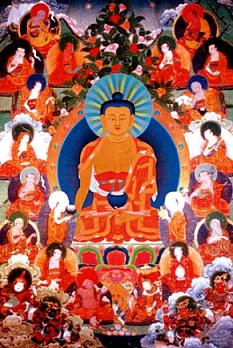Sixteen Arhats: Difference between revisions
No edit summary |
|||
| (35 intermediate revisions by 8 users not shown) | |||
| Line 1: | Line 1: | ||
[[Image:Buddha16Arhats.JPG|frame|'''Buddha and the Sixteen Arhats | [[Image:Buddha16Arhats.JPG|frame|[[Buddha]] and the Sixteen Arhats]] | ||
'''Sixteen [[Arhat]]s''' or '''Sthaviras''' (Skt. ''Ṣoḍaśa Sthavirāḥ''; Tib. གནས་བརྟན་བཅུ་དྲུག, ''Neten Chudruk'', [[Wyl.]] ''gnas brtan bcu drug'') — [[Buddha Shakyamuni]] personally selected the Sixteen Arhats from amongst his disciples and requested them to remain in the world, protecting the [[Dharma]] for as long as beings are capable of benefitting from the teachings. They vowed at the time of the [[parinirvana]] to remain in the world and maintain the Dharma until the time of the future Buddha [[Maitreya]]. To visualize the [[Buddha Shakyamuni]] surrounded by the Sixteen Arhats and an assembly of [[bodhisattva]]s generates great [[merit]] and quickly develops insight into the teachings of the Buddha. | |||
#[[Angaja]] (Tib. Yenlag Chung) | |||
#[[Ajita]] (Tib. Ma Phampa) | |||
#[[Vanavasin]] (Tib. Nagnanepa) | |||
#[[Mahakalika]] (Tib. Düden Chenpo) | |||
#[[Vajriputra]] (Tib. Dorje Möbu) | |||
#[[Shribhadra]] (Tib. Pal Zangpo) | |||
#[[Kanakavatsa]] (Tib. Sergyi Be'u) | |||
#[[Kanaka]] (Tib. Serchen) | |||
#[[Bakula]] (Tib. Bakula) | |||
#[[Rahula]], the Buddha's son (Tib. Drachen Dzin) | |||
#[[Chulapanthaka]] (Tib. Lamtren Ten) | |||
#[[Pindola Bharadvaja]] (Tib. Bharadodza Sönyom Len) | |||
#[[Panthaka]] (Tib. Lamchenten) | |||
#[[Nagasena]] (Tib. Lüdé) | |||
#[[Gopaka]] (Tib. Bechepa) | |||
#[[Abhedya]] (Tib. Michepa) | |||
The Sixteen Arhats are usually shown in [[thangka]]s accompanied by their two attendants, [[Hva Shang]] and [[Upasaka Dharmatala]] and by the [[Four Great Kings]]. | |||
==Further Reading== | ==Further Reading== | ||
===In Tibetan=== | ===In Tibetan=== | ||
*[[Mipham Rinpoche]], '''phags pa'i gnas brtan chen po bcu drug gi lo rgyus mdor bsdus'' | *[[Mipham Rinpoche]], '''phags pa'i gnas brtan chen po bcu drug gi lo rgyus mdor bsdus'' | ||
===In English=== | |||
*''Crystal Mirror, volume VI'', Dharma Publishing 1984 | |||
*M. W. de Visser, ''The Arhats in China and Japan'', Oesterheld & Co. Berlin, 1923 | |||
*Tate, J. 'The Sixteen Arhats in Tibetan Painting,' in ''Oriental Art'' 35, 4 1989/90, pp. 196-206 | |||
==External Links== | ==External Links== | ||
*[http://www. | *{{LH|topics/sixteen-arhats|A selection of texts related to the Sixteen Arhats on Lotsawa House}} | ||
*[http://www.himalayanart.org/pages/arhat/index.html The Sixteen Arhats outline page at Himalayan Art Resources] | |||
*[https://khenposodargye.org/books/ebooks/homage-and-offerings-to-the-sixteen-elders/ Homage and Offerings to the Sixteen Elders Composed by Pandita Shakyashri & Commented by Khenpo Sodargye] | |||
==Gallery== | |||
'''The Sixteen Arhats''' | |||
<Gallery> | |||
Image:Angaja.jpg|Angiraja | |||
Image:Ajita.jpg|Ajita | |||
Image:Vanavasin.jpg|Vanavasin | |||
Image:Kalika.jpg|Maha Kalika | |||
Image: Vajriputra.jpg|Vajriputra | |||
Image:Sribhadra.jpg|Shibhadra | |||
Image:Kanakavatsa.jpg|Kanakavatsa | |||
Image:Kanaka.jpg|Kanaka | |||
Image:Bakula.jpg|Bakula | |||
Image:Rahula.jpg|Rahula | |||
Image:Chulapanthaka.jpg|Chulapanthaka | |||
Image:Pindola.jpg|Pindola Bharadvaja | |||
Image:Panthaka.jpg|Panthaka | |||
Image:Nagasena.jpg|Nagasena | |||
Image:Gopaka.jpg|Gopaka | |||
Image:Abhedya.jpg|Abhedya | |||
</gallery> | |||
'''The Two Attendants''' | |||
<Gallery> | |||
Image:Hva_Shang.jpg|Hva Shang | |||
Image:Dharmatala.jpg|Dharmatala | |||
</gallery> | |||
'''The Four Great Kings''' | |||
<Gallery> | |||
Image:Dhritarashtra.jpg|Dhritarashtra | |||
Image:VirudhakaTST.jpg|Virudhaka | |||
Image:VirupaksaTST.jpg|Virupaksa | |||
Image:VaisravanaTST.jpg|Vaisravana | |||
</gallery> | |||
[[Category:Buddhas and Deities]] | |||
[[Category:Sixteen Arhats]] | |||
[[Category:Buddha Shakyamuni's Disciples]] | |||
[[Category:Enumerations]] | [[Category:Enumerations]] | ||
[[Category: | [[Category:16-Sixteen]] | ||
Latest revision as of 09:13, 14 November 2022

Sixteen Arhats or Sthaviras (Skt. Ṣoḍaśa Sthavirāḥ; Tib. གནས་བརྟན་བཅུ་དྲུག, Neten Chudruk, Wyl. gnas brtan bcu drug) — Buddha Shakyamuni personally selected the Sixteen Arhats from amongst his disciples and requested them to remain in the world, protecting the Dharma for as long as beings are capable of benefitting from the teachings. They vowed at the time of the parinirvana to remain in the world and maintain the Dharma until the time of the future Buddha Maitreya. To visualize the Buddha Shakyamuni surrounded by the Sixteen Arhats and an assembly of bodhisattvas generates great merit and quickly develops insight into the teachings of the Buddha.
- Angaja (Tib. Yenlag Chung)
- Ajita (Tib. Ma Phampa)
- Vanavasin (Tib. Nagnanepa)
- Mahakalika (Tib. Düden Chenpo)
- Vajriputra (Tib. Dorje Möbu)
- Shribhadra (Tib. Pal Zangpo)
- Kanakavatsa (Tib. Sergyi Be'u)
- Kanaka (Tib. Serchen)
- Bakula (Tib. Bakula)
- Rahula, the Buddha's son (Tib. Drachen Dzin)
- Chulapanthaka (Tib. Lamtren Ten)
- Pindola Bharadvaja (Tib. Bharadodza Sönyom Len)
- Panthaka (Tib. Lamchenten)
- Nagasena (Tib. Lüdé)
- Gopaka (Tib. Bechepa)
- Abhedya (Tib. Michepa)
The Sixteen Arhats are usually shown in thangkas accompanied by their two attendants, Hva Shang and Upasaka Dharmatala and by the Four Great Kings.
Further Reading
In Tibetan
- Mipham Rinpoche, 'phags pa'i gnas brtan chen po bcu drug gi lo rgyus mdor bsdus
In English
- Crystal Mirror, volume VI, Dharma Publishing 1984
- M. W. de Visser, The Arhats in China and Japan, Oesterheld & Co. Berlin, 1923
- Tate, J. 'The Sixteen Arhats in Tibetan Painting,' in Oriental Art 35, 4 1989/90, pp. 196-206
External Links
 A selection of texts related to the Sixteen Arhats on Lotsawa House
A selection of texts related to the Sixteen Arhats on Lotsawa House- The Sixteen Arhats outline page at Himalayan Art Resources
- Homage and Offerings to the Sixteen Elders Composed by Pandita Shakyashri & Commented by Khenpo Sodargye
Gallery
The Sixteen Arhats
-
Angiraja
-
Ajita
-
Vanavasin
-
Maha Kalika
-
Vajriputra
-
Shibhadra
-
Kanakavatsa
-
Kanaka
-
Bakula
-
Rahula
-
Chulapanthaka
-
Pindola Bharadvaja
-
Panthaka
-
Nagasena
-
Gopaka
-
Abhedya
The Two Attendants
-
Hva Shang
-
Dharmatala
The Four Great Kings
-
Dhritarashtra
-
Virudhaka
-
Virupaksa
-
Vaisravana





















